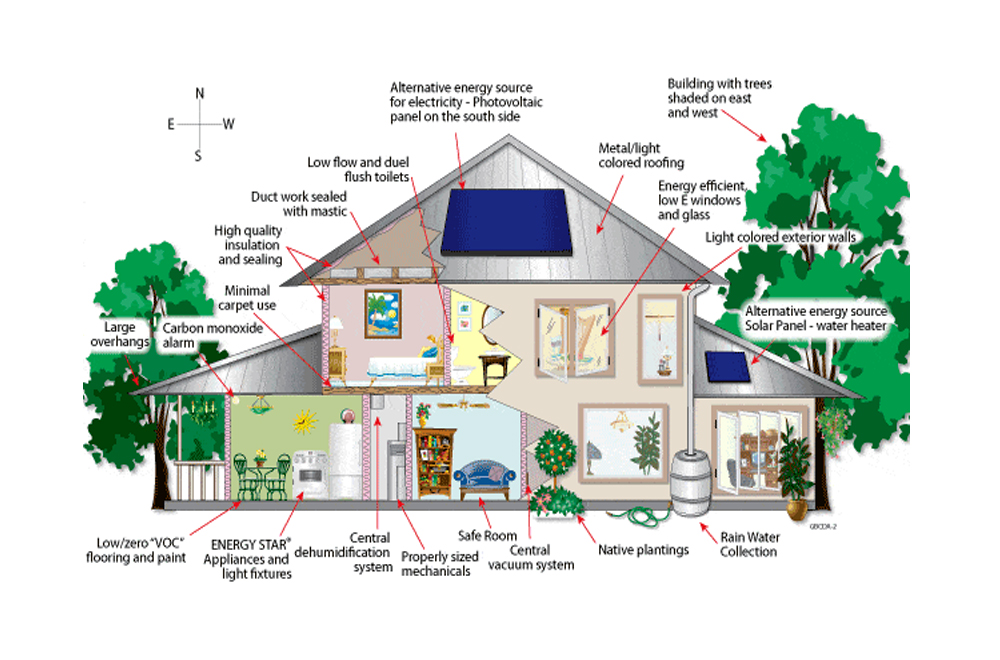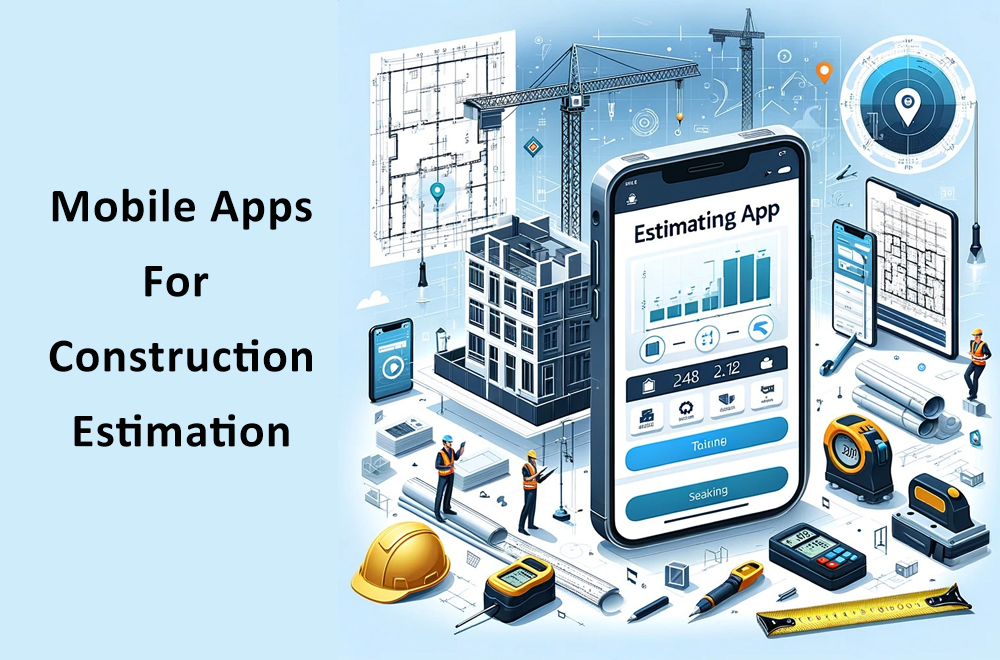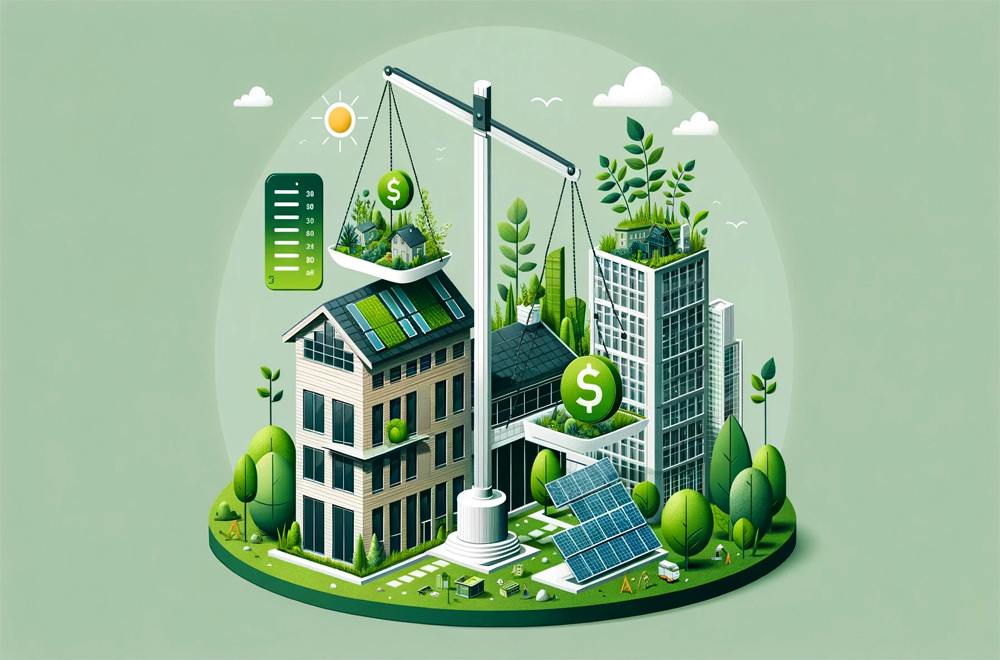In the evolving landscape of construction, the concept of green building has emerged as a cornerstone for sustainable development. As the world grapples with environmental challenges, integrating sustainability into construction planning is not just a trend but a necessity. This integration promises to redefine the essence of architectural innovation, marrying environmental responsibility with aesthetic and functional excellence. The journey toward sustainable construction begins with green building estimates, where the vision for eco-friendly structures is quantified and planned.
Table of Contents
ToggleWhat is a Green Building?
Green building is a construction approach that seeks to minimize the environmental impact of buildings by efficiently using energy, water, and other resources. It involves designing and constructing buildings with consideration for their environmental effects over the entire lifecycle, including their construction, operation, maintenance, and eventual demolition.
Green buildings use sustainable or recycled materials and incorporate technologies that reduce their carbon footprint, enhance energy efficiency, and conserve water. The goal is to create healthier, more energy-efficient, and cost-saving spaces for people to live, work, and play.
Early Integration of Sustainability in Construction Planning
Integrating sustainability at the early stages of construction planning is crucial for several reasons. First, it sets a clear direction for the entire project, ensuring that sustainability is not an afterthought but a foundational principle guiding all decisions. Early integration allows for a holistic approach, where every element of the building’s design, from site selection to materials and energy sources, is chosen based on its environmental impact.
This proactive approach to sustainability can significantly reduce costs and increase efficiency. By considering green solutions from the outset, project teams can avoid the need for costly retrofits or modifications down the line.
Moreover, early planning for sustainability fosters innovation, encouraging architects and builders to explore new materials, technologies, and techniques that push the boundaries of green construction.
The benefits of this early integration extend beyond the immediate project. Sustainable buildings offer lower operating costs, improved occupant health and productivity, and a reduced carbon footprint. They contribute positively to their communities and the environment, setting a standard for future developments.
Furthermore, as regulations and expectations for environmental stewardship tighten, early integration of sustainability positions projects to meet and exceed these standards, providing a competitive edge in the marketplace.
The Importance of Early Planning for Sustainability
Impact of Green Building Planning Construction Success
Early planning is the linchpin of sustainable construction success, setting the stage for the integration of green practices throughout the project lifecycle. This phase allows for a comprehensive assessment of the environmental impact of the proposed construction, enabling teams to make informed decisions that align with sustainability goals. The impact of such planning is multifaceted, touching on every aspect of the construction process, from the choice of materials to energy management strategies.
A well-orchestrated plan considers the building’s location, orientation, and design, optimizing natural light and ventilation to reduce energy consumption. It also involves selecting eco-friendly materials that are durable, recyclable, and have a low carbon footprint. Such meticulous planning ensures that sustainability is woven into the fabric of the construction project, leading to buildings that are not only environmentally responsible but also economically viable and socially beneficial.
Benefits of Integrating Green Practices from the Start
Integrating green practices at the outset of a construction project offers a plethora of benefits. Economically, it can lead to significant cost savings by reducing energy and water usage, lowering maintenance costs, and enhancing the building’s value. Environmentally, early integration helps minimize the building’s carbon footprint, conserve natural resources, and promote biodiversity. Socially, it improves occupant health and well-being by providing better indoor air quality and access to natural light.
Moreover, starting with sustainability in mind encourages innovation and creativity, pushing architects and builders to explore alternative materials, renewable energy sources, and advanced technologies. This proactive approach also facilitates compliance with environmental regulations and standards, avoiding potential legal and financial penalties. Additionally, green buildings have a competitive edge in the market, appealing to environmentally conscious buyers and tenants seeking healthier, more sustainable living spaces.
Challenges of Integrating Sustainability
Common Obstacles and How to Overcome Them
Despite the clear advantages, integrating sustainability into construction planning is not without its challenges. One common obstacle is the perceived high upfront costs associated with green materials and technologies. To overcome this, it’s crucial to focus on the long-term benefits and cost savings that sustainable practices bring, such as reduced utility bills and maintenance costs. Financial incentives and subsidies for green buildings can also offset initial expenses.
Another challenge is the lack of knowledge and experience among stakeholders regarding sustainable construction practices. This can be addressed through education and training programs, along with the sharing of best practices within the industry. Utilizing experienced green building consultants can further bridge this knowledge gap.
Resistance to change and the inertia of traditional construction methods pose additional hurdles. Overcoming these requires strong leadership and a commitment to sustainability from all project stakeholders. Setting clear sustainability goals and incorporating them into the project’s vision can help align the efforts of all parties involved.
The Role of Stakeholders in Supporting Sustainability
The successful integration of sustainability in construction projects relies heavily on the active involvement and support of all stakeholders, including developers, architects, contractors, government agencies, and the community. Each group has a unique role to play in promoting green building practices.
Developers and owners must prioritize sustainability from the project’s inception, providing the necessary resources and support. Architects and engineers are responsible for designing energy-efficient and environmentally friendly buildings, while contractors must implement sustainable practices on the construction site. Government agencies can encourage green building by enacting supportive policies, regulations, and incentives. Lastly, the community’s support for sustainable development projects can drive demand for green buildings, encouraging more developers to adopt sustainable practices.
Collaboration and communication among stakeholders are key to overcoming challenges and maximizing the benefits of green building. By working together, stakeholders can ensure that sustainability is not just an aspiration but a reality in construction planning and execution.
Tools and Strategies for Green Building Planning
Software and Methodologies for Sustainable Construction Planning
The integration of sustainability into construction planning is supported by a variety of sophisticated software and methodologies. These tools facilitate the design, analysis, and management of green buildings, making it easier for teams to achieve their sustainability goals.
Building Information Modeling (BIM) stands out as a pivotal technology, allowing architects, engineers, and construction professionals to collaboratively design and visualize the sustainable aspects of a building in a 3D model. BIM supports energy analysis, material selection, and the simulation of building performance, helping teams make informed decisions that enhance sustainability.
Life Cycle Assessment (LCA) software provides another critical tool, enabling the analysis of the environmental impacts of building materials and components over their entire lifecycle, from extraction and manufacturing to disposal. By identifying the most eco-friendly materials and practices, LCA helps minimize the environmental footprint of construction projects.
Energy modeling software allows for the detailed simulation of a building’s energy consumption, taking into account local climate conditions, building orientation, and the efficiency of HVAC and lighting systems. This enables the optimization of building design for energy conservation and the selection of renewable energy sources.
How to Effectively Estimate Costs and Benefits
Effectively estimating the costs and benefits of green building initiatives involves a holistic approach that considers both immediate financial outlays and long-term savings. Cost-benefit analysis (CBA) is a critical tool in this process, comparing the upfront costs of sustainable features against the projected savings in energy, water, and maintenance over the building’s lifecycle. Understanding sustainable construction costs and ROI is crucial in this regard.
To accurately estimate these costs and benefits, it’s essential to incorporate the value of non-monetary benefits such as improved occupant health and productivity, enhanced brand reputation, and contribution to environmental conservation. Additionally, leveraging incentives, grants, and certification programs can provide financial benefits that further offset the initial costs of implementing sustainable practices.
Benefits of Early Integration of Sustainability
Environmental, Economic, and Social Benefits
The early integration of sustainability in construction planning yields profound benefits across environmental, economic, and social spheres. Environmentally, it contributes to the reduction of greenhouse gas emissions, conserves natural resources, and enhances biodiversity. Economically, sustainable buildings often result in lower operating costs, higher property values, and increased marketability. Socially, they offer healthier and more comfortable living and working environments, which can improve occupant well-being and productivity.
Case Studies Showcasing Successful Integration
Several case studies highlight the successful integration of sustainability into construction planning:
The Edge, Amsterdam: Dubbed the world’s greenest building, The Edge incorporates an intelligent design that maximizes natural light and ventilation, coupled with an energy-efficient LED lighting system powered by solar panels. The building features a rainwater collection system for flushing toilets and watering plants, showcasing how innovative design can achieve significant environmental and economic benefits.
The Bullitt Center, Seattle: This commercial building is one of the most energy-efficient in the world, meeting the rigorous standards of the Living Building Challenge. It generates its own electricity through solar panels, uses rainwater for all its water needs, and processes its wastewater on-site. The Bullitt Center demonstrates the feasibility and benefits of creating fully sustainable urban buildings.
These case studies exemplify how early planning and integration of sustainability can lead to groundbreaking achievements in green building, serving as a model for future construction projects worldwide. By prioritizing sustainability from the outset, construction projects can mitigate their environmental impact and provide lasting economic and social benefits.
Tips for Incorporating Sustainability into Construction Estimates
Practical Advice for Construction Professionals
Incorporating sustainability into construction estimates requires a nuanced understanding of both the costs and benefits of green building practices. Here are some practical tips for construction professionals:
- Start with a Sustainability Audit: Before drafting estimates, conduct a thorough audit of the project to identify opportunities for incorporating sustainable practices. Consider energy, water, materials, and site impact.
- Use Life Cycle Cost Analysis (LCCA): LCCA helps you evaluate the total cost of building ownership, including initial construction costs and ongoing operating expenses, against the long-term savings from sustainability features.
- Leverage Green Building Software Tools: Utilize software tools designed for green building analysis, such as BIM and LCA tools, to accurately estimate the environmental impact and cost savings of sustainable materials and technologies. Explore effective cost-saving measures in construction here.
- Seek Expert Advice: Collaborate with sustainability consultants or green building experts who can provide insights into the most effective sustainability practices and technologies for your project.
- Incorporate Renewable Energy Early: Plan for renewable energy sources, like solar or wind power, early in the design process to maximize their integration and cost-effectiveness.
Resources for Further Learning and Assistance
To stay abreast of the latest in sustainable construction, consider the following resources:
- Green Building Certification Programs: Programs like LEED (Leadership in Energy and Environmental Design) and BREEAM offer guidelines, courses, and certifications for sustainable building.
- Professional Associations: Join associations such as the U.S. Green Building Council (USGBC) or the Green Building Council in your country for access to workshops, seminars, and networking opportunities.
- Online Courses and Webinars: Platforms like Coursera, LinkedIn Learning, and the World Green Building Council offer courses on sustainable design, green building materials, and energy efficiency.
- Industry Publications: Stay informed with the latest research and case studies on sustainable construction through journals and magazines dedicated to green building.
Conclusion
The integration of sustainability into construction planning is more than an environmental imperative—it’s a strategic approach that offers significant economic and social benefits. By adopting green building practices from the early planning stages, construction professionals can create buildings that are not only environmentally responsible but also economically viable and beneficial for occupant well-being.
We invite our readers to share their experiences with sustainable construction or consider the principles of sustainability in their next project. Whether you’re a seasoned professional or new to the field of green building, your commitment to sustainability can make a difference. Share your stories, challenges, and successes in the comments below or on social media. Together, we can build a more sustainable future.
Your insights and contributions are valuable to us and to the wider community striving for a greener, more sustainable built environment. Let’s continue to push the boundaries of what’s possible in sustainable construction and set new benchmarks for the industry.





